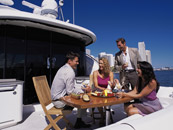Out on the boat, few things are more rewarding than popping the top on your favorite canned beverage and taking a long swig to cool your parched throat. The trick is, how do you keep refreshments and food cold on a hot summer’s day?
Coolers
There are several ways to keep food cold. A big, insulated cooler packed with ice is a good choice for day trips. Coolers are portable, keep ice frozen for a long time and they’re inexpensive. The top of the cooler can double as an extra seat, too.
The downside is that the ice is usually melted by the end of the day—but by then, you’re probably heading back to the dock anyway.
Ice Boxes
Think of an icebox as a well-insulated, built in cooler. A big block of ice in the top of the icebox does a surprisingly good job at maintaining reasonably cool temperatures—and the block of ice can last a few days, depending on the air temperature and how many times you open the door (letting the cold air escape).
Since an icebox uses no electricity, it doesn’t have any electrical components to fail, and draws no current at all from your boat’s batteries.
Refrigerators
How about a refrigerator for your boat? Granted, a boat’s fridge is small, about the size of a mini-bar or dorm room refrigerator, but it’ll keep sandwiches, salads, and refreshments pretty cold. Refrigerator/freezer units can also make a couple of trays of ice cubes throughout the day, which is fine for just a couple of crewmembers.
Refrigerators are electrical appliances, and that electrical power has to come from somewhere, usually your boat’s batteries or a generator. Some marine refrigerators run off the batteries while you’re underway, and use 110-volt current when the boat’s docked and plugged into shore power.
